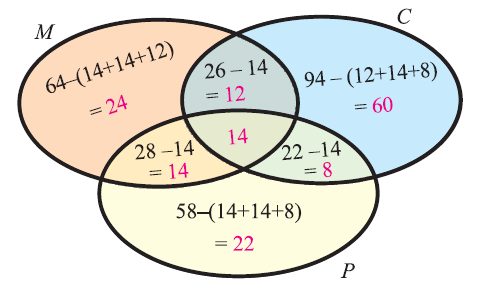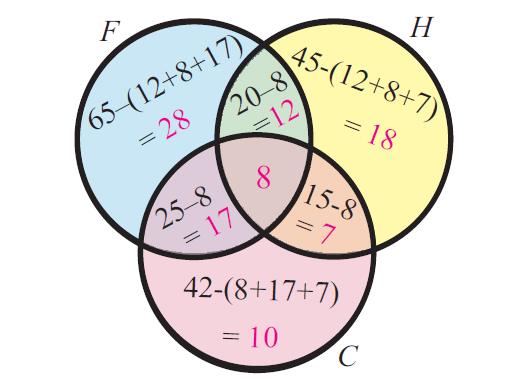SETS WORD PROBLEMS WORKSHEET
Problem 1 :
In a survey of university students, 64 had taken mathematics course, 94 had taken chemistry course, 58 had taken physics course, 28 had taken mathematics and physics, 26 had taken mathematics and chemistry, 22 had taken chemistry and physics course, and 14 had taken all the three courses. Find how many had taken one course only.
Problem 2 :
In a group of students, 65 play foot ball, 45 play hockey, 42 play cricket, 20 play foot ball and hockey, 25 play foot ball and cricket, 15 play hockey and cricket and 8 play all the three games. Find the total number of students in the group. (Assume that each student in the group plays at least one game.)
Problem 3 :
In a class of 60 students, 40 students like math, 36 like science, 24 like both the subjects.
Find the number of students who like
(i) Math only, (ii) Science only (iii) Either Math or Science (iv) Neither Math nor science.
Problem 4 :
At a certain conference of 100 people there are 29 Indian women and 23 Indian men. Out of these Indian people 4 are doctors and 24 are either men or doctors. There are no foreign doctors. Find the number of women doctors attending the conference.

Detailed Answer Key
Problem 1 :
In a survey of university students, 64 had taken mathematics course, 94 had taken chemistry course, 58 had taken physics course, 28 had taken mathematics and physics, 26 had taken mathematics and chemistry, 22 had taken chemistry and physics course, and 14 had taken all the three courses. Find how many had taken one course only.
Solution :
Step 1 :
Let M, C, P represent sets of students who had taken mathematics, chemistry and physics respectively
Step 2 :
From the given information, we have
n(M) = 64 , n(C) = 94, n(P) = 58,
n(MnP) = 28, n(MnC) = 26, n(CnP) = 22
n(MnCnP) = 14
Step 3 :
From the basic stuff, we have
No. of students who had taken only Math is
= n(M) - [n(MnP) + n(MnC) - n(MnCnP)]
= 64 - [28+26-14]
= 64 - 40
= 24
Step 4 :
No. of students who had taken only Chemistry is
= n(C) - [n(MnC) + n(CnP) - n(MnCnP)]
= 94 - [26+22-14]
= 94 - 34
= 60
Step 5 :
No. of students who had taken only Physics is
= n(P) - [n(MnP) + n(CnP) - n(MnCnP)]
= 58 - [28+22-14]
= 58 - 36
= 22
Step 6 :
Total no. of students who had taken only one course
= 24 + 60 + 22
= 106
So, the total number of students who had taken only one course is 106.
Alternative Method (Using venn diagram)
Step 1 :
Venn diagram related to the information given in the question:

Step 2 :
From the venn diagram above, we have
No. of students who had taken only math = 24
No. of students who had taken only chemistry = 60
No. of students who had taken only physics = 22
Step 3 :
Total no. of students who had taken only one course is
= 24 + 60 + 22
= 106
Problem 2 :
In a group of students, 65 play foot ball, 45 play hockey, 42 play cricket, 20 play foot ball and hockey, 25 play foot ball and cricket, 15 play hockey and cricket and 8 play all the three games. Find the total number of students in the group. (Assume that each student in the group plays at least one game.)
Solution :
Step 1 :
Let F, H and C represent the set of students who play foot ball, hockey and cricket respectively.
Step 2 :
From the given information, we have
n(F) = 65, n(H) = 45, n(C) = 42,
n(FnH) = 20, n(FnC) = 25, n(HnC) = 15
n(FnHnC) = 8
Step 3 :
From the basic stuff, we have
Total number of students in the group is
= n(F) + n(H) + n(C) - n(FnH) - n(FnC) - n(HnC) + n(FnHnC)
= 65 + 45 + 42 -20 - 25 - 15 + 8
= 100
So, the total number of students in the group is 100.
Alternative Method (Using venn diagram)
Step 1 :
Venn diagram related to the information given in the question:

Step 2 :
Total number of students in the group is
= 28 + 12 + 18 + 7 + 10 + 17 + 8
= 100
Problem 3 :
In a class of 60 students, 40 students like math, 36 like science, 24 like both the subjects.
Find the number of students who like
(i) Math only, (ii) Science only (iii) Either Math or Science (iv) Neither Math nor science.
Solution :
Step 1 :
Let M and S represent the set of students who like math and science respectively.
Step 2 :
From the information given in the question, we have
n(M) = 40, n(S) = 36, n(MnS) = 24
Step 3 :
Answer (i) : No. of students who like math only
= n(M) - n(MnS)
= 40 - 24
= 16
Step 4 :
Answer (ii) : No. of students who like science only
= n(S) - n(MnS)
= 36 - 24
= 12
Step 5 :
Answer (iii) : No. of students who like either math or science
= n(M or S)
= n(MuS)
= n(M) + n(S) - n(MnS)
= 40 + 36 - 24
= 52
Step 6 :
Answer (iv) :
Total no. students who like any of the two subjects = n(MuS) = 52
No. of students who like neither math nor science
= 60 - 52
= 8
Problem 4 :
At a certain conference of 100 people there are 29 Indian women and 23 Indian men. Out of these Indian people 4 are doctors and 24 are either men or doctors. There are no foreign doctors. Find the number of women doctors attending the conference.
Solution :
Step 1 :
Let M and D represent the set of Indian men and Doctors respectively.
Step 2 :
From the information given in the question, we have
n(M) = 23, n(D) = 4, n(MuD) = 24,
Step 3 :
From the basic stuff, we have
n(MuD) = n(M) + n(D) - n(MnD)
24 = 23 + 4 - n(MnD)
n(MnD) = 3
n(Indian Men and Doctors) = 3
Step 4 :
So, out of the 4 Indian doctors, there are 3 men.
And the remaining 1 is Indian women doctor.
Hence, the number women doctors attending the conference is 1
Kindly mail your feedback to v4formath@gmail.com
We always appreciate your feedback.
©All rights reserved. onlinemath4all.com
Recent Articles
-
Logarithmic Derivative Problems and Solutions
Apr 16, 25 09:25 PM
Logarithmic Derivative Problems and Solutions -
Digital SAT Math Problems and Solutions (Part - 145)
Apr 16, 25 12:35 PM
Digital SAT Math Problems and Solutions (Part - 145) -
Digital SAT Math Problems and Solutions (Part - 144)
Apr 14, 25 07:27 PM
Digital SAT Math Problems and Solutions (Part - 144)

